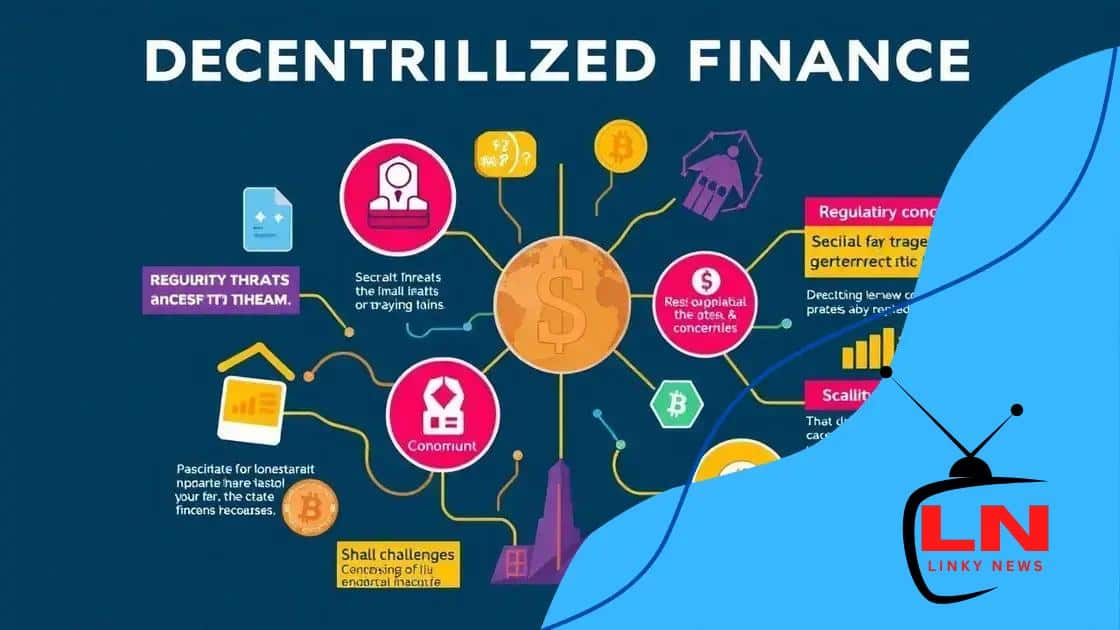Decentralized finance evolution: what you need to know

Decentralized finance (DeFi) revolutionizes traditional financial systems by offering greater accessibility, lower costs, and innovative applications, while facing challenges like security risks and regulatory uncertainties.
Decentralized finance evolution is reshaping our financial landscape, removing intermediaries and providing greater access to financial services. Have you ever wondered how this might impact your daily life?
Understanding decentralized finance
Understanding decentralized finance is crucial in today’s evolving financial ecosystem. It empowers individuals by offering a system that is not reliant on traditional banks.
Decentralized finance, commonly referred to as DeFi, introduces remarkable changes to the financial landscape. Traditional finance has many barriers, but with DeFi, anyone can participate in financial activities using blockchain technology.
Key Characteristics of DeFi
DeFi platforms operate on smart contracts, which are self-executing contracts with the terms directly written into code. This approach ensures transparency and security for users, as the operations are recorded on public blockchains.
- Accessibility: Anyone with internet access can participate.
- Transparency: All transactions are visible and auditable.
- Control: Users retain full ownership of their assets.
Another significant aspect of DeFi is the use of cryptocurrencies. Users interact with these platforms through various digital assets, which serve as collateral or means of exchange. This leads to innovative practices that were not possible in conventional finance.
Benefits of Decentralized Finance
The advantages of DeFi are numerous. By eliminating intermediaries, users can enjoy lower fees and faster transactions. Furthermore, DeFi offers financial services that cater to the unbanked population, helping them access essential financial tools.
Moreover, DeFi facilitates investment opportunities that are accessible to all. Peer-to-peer lending and decentralized exchanges are just examples of how DeFi opens doors for everyone. Imagine lending cryptocurrency to a merchant directly, cutting out any middleman!
This decentralized approach fosters innovation, driving the creation of new services and products at a rapid pace. As more developers engage with DeFi infrastructure, the ecosystem continues to grow and evolve.
Challenges in DeFi
However, understanding decentralized finance also involves recognizing the challenges it faces. Issues like regulatory scrutiny, security vulnerabilities, and the volatility of cryptocurrencies can deter potential users. Despite these challenges, the potential for growth and transformation in finance makes DeFi worth exploring.
Investors and users alike must engage with DeFi cautiously and stay informed. By doing so, they can navigate the complexities and enjoy the benefits that this revolutionary financial system has to offer.
Key benefits of decentralized finance
The key benefits of decentralized finance are transforming how we think about financial services. By eliminating intermediaries, DeFi provides users with greater control over their assets.
One of the most significant advantages is accessibility. With a simple internet connection, anyone can participate in financial activities, such as lending, borrowing, and trading. This inclusivity has the potential to serve millions of unbanked individuals, opening up new opportunities.
Lower Costs
Another compelling benefit of DeFi is the reduction in costs. Traditional financial services often involve high fees for transactions and account management. In contrast, DeFi platforms usually charge lower fees or none at all. By using blockchain technology, users can interact directly, saving money in the process.
- No hidden fees or charges.
- Direct peer-to-peer transactions.
- Minimized transaction times.
Security is also a notable advantage. Many DeFi platforms utilize advanced cryptography to protect user assets. Funds are often held in smart contracts, which have clear rules and reduce the risk of fraud.
Open and Transparent
DeFi platforms are built on public blockchains, promoting transparency. This openness enables users to independently verify all transactions, ensuring trust among participants. Users can trace the flow of funds without relying on a central authority.
Moreover, the innovative nature of DeFi fosters financial creativity. Users can engage in activities like yield farming and liquidity mining to maximize earnings. These processes allow individuals to earn rewards simply by providing liquidity to platforms, enhancing their financial strategies.
Additionally, the rapid pace of innovation in the DeFi space introduces new products and services frequently. This dynamic environment attracts developers who create diverse solutions, enriching the overall ecosystem.
As potential users learn about DeFi, understanding these key benefits can empower them to embrace this shift in the financial paradigm. By leveraging DeFi’s strengths, individuals can participate in a more inclusive and efficient financial landscape.
Challenges faced by decentralized finance

The challenges faced by decentralized finance are important to understand for anyone looking to engage in this innovative financial space. While DeFi offers many advantages, it also presents certain risks and obstacles.
One major challenge is security. DeFi platforms are built on smart contracts, which are susceptible to bugs and vulnerabilities. If a bug is exploited, users can lose their funds quickly. This highlights the need for thorough audits and a keen understanding of the technology.
Regulatory Issues
Another significant challenge is the lack of regulatory frameworks governing DeFi. Many platforms operate in a gray area, which can lead to uncertainty for users and developers. As governments around the world scramble to create regulations, the future of DeFi may depend on how these laws are shaped.
- Potential for sudden policy changes.
- Risk of government oversight.
- Unclear tax implications for users.
Moreover, the volatility of cryptocurrencies poses another risk. Prices can fluctuate wildly, making it difficult for users to make informed decisions. This can be especially concerning for those who are new to the crypto space.
Scalability Issues
Scalability is also a concern. As more users flock to DeFi platforms, many struggle to handle the volume. High transaction fees and slow processing times are common problems that frustrate users. Finding a solution to improve scalability while maintaining security is essential for the growth of DeFi.
As these challenges emerge, potential users need to stay informed and exercise caution. Understanding the risks involved is crucial for navigating the complex landscape of decentralized finance. Awareness of these issues can empower users to make smarter decisions and protect their assets.
Real-world applications of decentralized finance
Real-world applications of decentralized finance are altering how we interact with traditional financial systems. DeFi technology makes it possible for users to access financial services directly through blockchain networks, eliminating the need for intermediaries.
A major area where DeFi is making strides is lending. Users can lend their cryptocurrencies to others and earn interest without relying on banks. This means better rates for borrowers and higher returns for lenders. People can also collateralize their assets to borrow funds quickly, facilitating a seamless financial experience.
Decentralized Exchanges (DEX)
Decentralized exchanges, or DEXs, are another prominent application. They allow users to swap cryptocurrencies directly without a central authority. This enhances privacy and reduces the risks involved with centralized exchanges, where users must deposit their funds.
- Support for a wide range of cryptocurrencies.
- Lower fees compared to traditional exchanges.
- Control over funds during trading.
Yield farming is also a popular DeFi application. Users can provide liquidity to various platforms and earn rewards, often in the form of additional tokens. This practice encourages the growth of liquidity pools, which are essential for the ecosystem’s functionality.
Insurance and Tokenization
DeFi also offers innovative insurance solutions. Users can insure their digital assets against theft or smart contract failures. This adds an extra layer of security and helps users feel more confident participating in DeFi.
Another significant application is the tokenization of real-world assets. By representing physical assets like real estate or art as tokens on the blockchain, users can buy, sell, and trade fractions of these assets. This promotes liquidity and opens investment opportunities to a broader audience.
As DeFi continues to develop, its applications expand. These innovative solutions are enhancing financial inclusivity and giving users more control over their financial futures.
Future trends in decentralized finance
Future trends in decentralized finance are poised to shape the financial landscape significantly. As the DeFi space matures, we can expect several exciting developments that will enhance accessibility and usability.
One major trend is the integration of artificial intelligence (AI) with DeFi services. AI can improve trading algorithms and risk assessment, providing users with smarter investment strategies. This technology allows for more personalized financial solutions based on user behavior and market trends.
Interoperability among Blockchains
Another critical trend is the push for interoperability between different blockchain networks. This will enable users to seamlessly transfer assets across various platforms and access a wider array of services. As more projects focus on cross-chain compatibility, the user experience will become smoother and more unified.
- Enhanced asset transfers between blockchain ecosystems.
- Broader access to different DeFi applications.
- Increased liquidity across markets.
The rise of decentralized autonomous organizations (DAOs) is also a noteworthy trend. DAOs enable participants to govern their financial applications democratically, giving users a voice in decision-making processes. This shift towards user control enhances trust and engagement within the DeFi community.
Focus on Sustainable Finance
In addition to governance, there is a growing emphasis on sustainable finance within DeFi. Many projects are exploring ways to ensure that their operations minimize negative environmental impacts. This includes using eco-friendly practices and supporting projects with positive social outcomes.
Finally, we can anticipate more robust regulatory frameworks to emerge. As decentralized finance gains popularity, regulatory bodies will likely establish clearer rules for DeFi activities. This will help protect consumers while allowing for continued innovation in the space.
As these trends unfold, the future of decentralized finance looks bright, with endless possibilities for innovation and growth.
FAQ – Frequently Asked Questions about Decentralized Finance
What are the main benefits of decentralized finance (DeFi)?
The main benefits of DeFi include increased accessibility, lower transaction costs, and greater control over personal assets.
What challenges does DeFi face today?
DeFi faces challenges such as security risks from smart contracts, regulatory uncertainty, and cryptocurrency volatility.
How do decentralized exchanges (DEXs) work?
DEXs allow users to trade cryptocurrencies directly without a central authority, enhancing privacy and reducing fees.
What are some future trends in DeFi?
Future trends include the integration of artificial intelligence, improved interoperability between blockchains, and a focus on sustainable finance.





